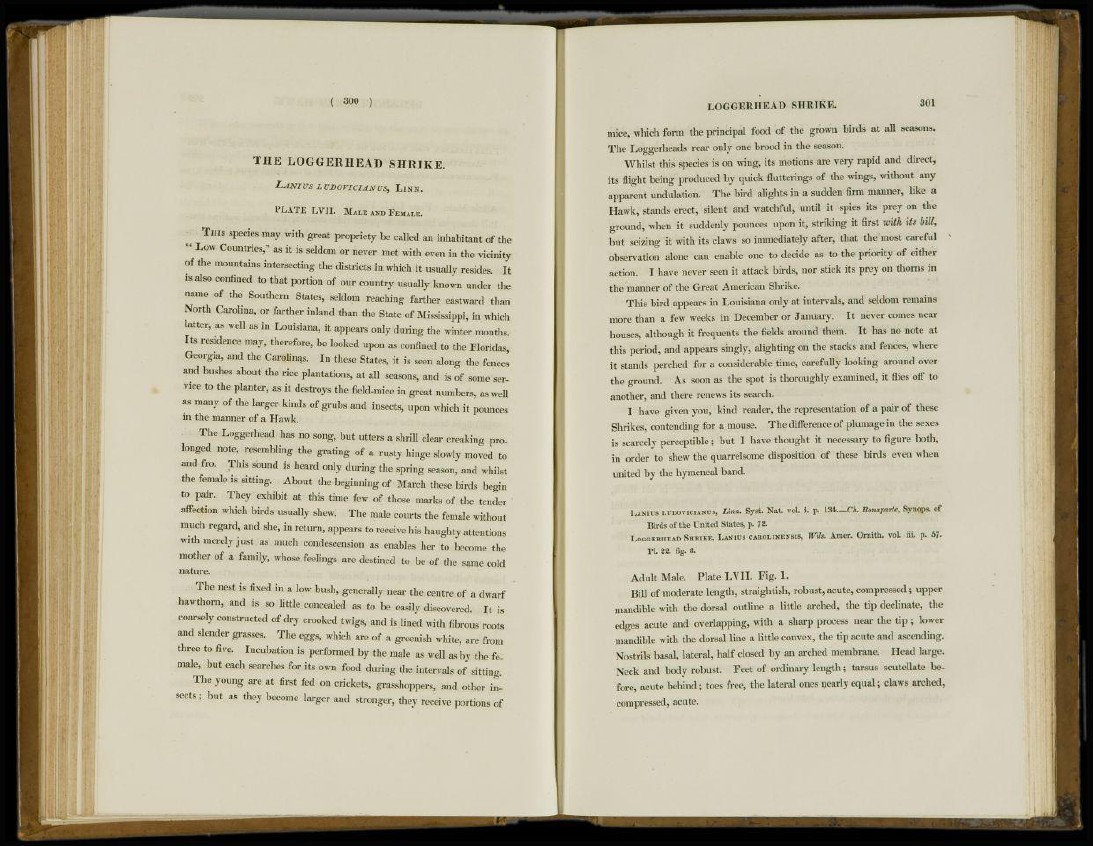
{ 300 )
T H E LOGGERHEAD SHRIKE.
LANI US LUDO VICIAN us, LINN.
P L A T E L V I I . M A L E A N D F E M A L E .
T H I S species may with great propriety be called an inhabitant of the
" Low Countries,'" as it is seldom or never met with even in the vicinity
of the mountains intersecting the districts in which it usually resides. It
is also confined to that portion of our country usually known under the
name of the Southern States, seldom reaching farther eastward than
North Carolina, or farther inland than the State of Mississippi, in which
latter, as well as in Louisiana, it appears only during the winter months.
Its residence may, therefore, be looked upon as confined to the Floridas,
Georgia, and the Carolines. In these States, it is seen along the fences
and bushes about the rice plantations, at all seasons, and is of some service
to the planter, as it destroys the field-mice in great numbers, as well
as many of the larger kinds of grubs and insects, upon which it pounces
in the manner of a Hawk.
The Loggerhead has no song, but utters a shrill clear creaking prolonged
note, resembling the grating of a rusty hinge slowly moved to
and fro. This sound is heard only during the spring season, and whilst
the female is sitting. About the beginning of March these birds begin
to pair. They exhibit at this time few of those marks of the tender
affection which birds usually shew. The male courts the female without
much regard, and she, in return, appears to receive his haughty attentions
with merely just as much condescension as enables her to become the
mother of a family, whose feelings are destined to be of the same cold
nature.
The nest is fixed in a low bush, generally near the centre of a dwarf
hawthorn, and is so little concealed as to be easily discovered. It is
coarsely constructed of dry crooked twigs, and is lined with fibrous roots
and slender grasses. The eggs, which are of a greenish white, are from
three to five. Incubation is performed by the male as well as by the female,
but each searches for its own food during the intervals of sitting.
The young are at first fed on crickets, grasshoppers, and other insects
; but as they become larger and stronger, they receive portions of
LOGGERHEAD SHRIKE. 301
mice, which form the principal food of the grown birds at all seasons.
The Loggerheads rear only one brood in the season.
Whilst this species is on wing, its motions are very rapid and direct,
its flight being produced by quick flutterings of the wings, without any
apparent undulation. The bird alights in a sudden firm manner, like a
Hawk, stands erect, silent and watchful, until it spies its prey on the
ground, when it suddenly pounces upon it, striking it first with its bill,
but seizing it with its claws so immediately after, that the most careful
observation alone can enable one to decide as to the priority of either
action. I have never seen it attack birds, nor stick its prey on thorns in
the manner of the Great American Shrike.
This bird appears in Louisiana only at intervals, and seldom remains
more than a few weeks in December or January. It never comes near
houses, although it frequents the fields around them. It has no note at
this period, and appears singly, alighting on the stacks and fences, where
it stands perched for a considerable time, carefully looking around over
the ground. As soon as the spot is thoroughly examined, it flies off to
another, and there renews its search.
I have given you, kind reader, the representation of a pair of these
Shrikes, contending for a mouse. The difference of plumagein the sexes
is scarcely perceptible; but I have thought it necessary to figure both,
in order to shew the quarrelsome disposition of these birds even when
united by the hymeneal band.
L A N I U S L U D O V I C I A N U S , Linn. Syst. Nat. vol. i. p. 134—Ch. Bonaparte, Synops. of
Birds of the United States, p. 12.
L O G G E R H E A D S H R I K E , L A N I U S C A R O L I N E N S I S , Wits. Amer. Ornith. vol. iii. p. 57.
PL 22. fig. 8.
Adult Male. Plate LVII. Fig. 1.
Bill of moderate length, straightish, robust, acute, compressed; upper
mandible with the dorsal outline a little arched, the tip declinate, the
edges acute and overlapping, with a sharp process near the tip ; lower
mandible with the dorsal line a little convex, the tip acute and ascending.
Nostrils basal, lateral, half closed by an arched membrane. Head large.
Neck and body robust. Feet of ordinary length; tarsus scutellate before,
acute behind; toes free, the lateral ones nearly equal; claws arched,
compressed, acute.